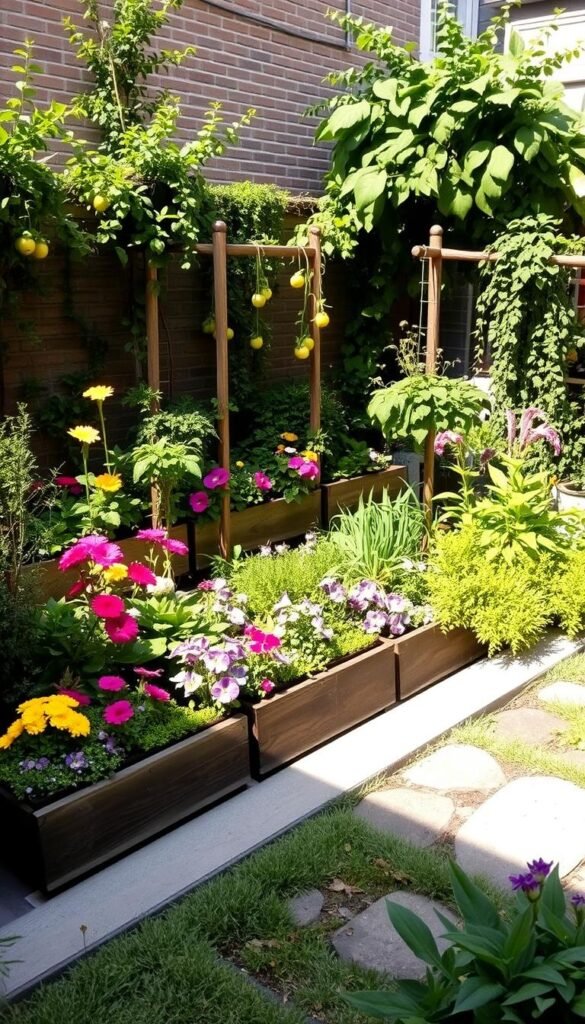Welcome to the art of reimagining cozy outdoor areas! If you’ve ever felt limited by your backyard’s size, you’re not alone. Many city dwellers face the challenge of making the most of their limited square footage. But here’s the secret: small-scale spaces hold big potential.
You don’t need acres to create a vibrant oasis. With smart design choices, even the tiniest corners can become functional, stylish extensions of your home. Think vertical planters that kiss the sky or foldable furniture that adapts to your needs. Every inch counts!
This guide will show you how to blend creativity with practicality. Discover ways to layer textures, choose space-saving plants, and use lighting to add depth. We’ll explore solutions tailored for urban environments, where balconies and patios often pull double duty.
Best part? These strategies work for any budget. Whether you’re a seasoned green thumb or just starting out, you’ll find inspiration that fits your lifestyle. Let’s turn those “what ifs” into “why didn’t I think of that sooner?” moments together!
Understanding Your Compact Urban Yard
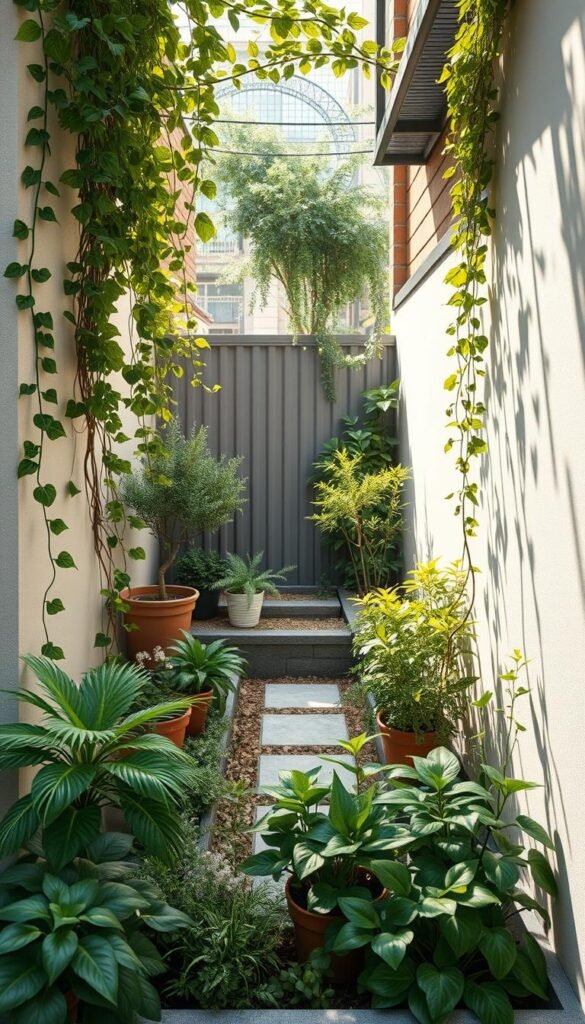
Your cozy yard isn’t just a space—it’s a blank slate waiting for transformation. Start by observing its quirks: irregular shapes, shifting sunlight patterns, or existing features like weathered brick walls. These “flaws” often hold the key to creative solutions.
Urban yards face unique challenges. Tall buildings might cast shadows, while pavement-heavy surroundings affect soil quality. Test your outdoor space for microclimates—areas that stay sunny, shady, or windy. A simple sun-tracking chart helps match plants to their ideal spots.
| Common Urban Challenges | Smart Solutions |
|---|---|
| Limited sunlight | Shade-loving plants like ferns or hostas |
| Poor drainage | Raised beds with gravel bases |
| Awkward angles | Corner shelves or triangular planters |
Don’t overlook vertical surfaces! Walls and fences support climbing vines or hanging herb gardens. Even overhead spaces work for suspended planters. Small areas thrive when every layer gets used—ground covers, mid-height shrubs, and tall greenery create depth.
Local conditions matter. Test soil pH, watch airflow patterns, and note noise levels. Collaborating with neighbors through community-driven green spaces can spark ideas for shared challenges. Your backyard might be compact, but its impact? Endless.
Innovative Small Garden Ideas for Compact Urban Yards
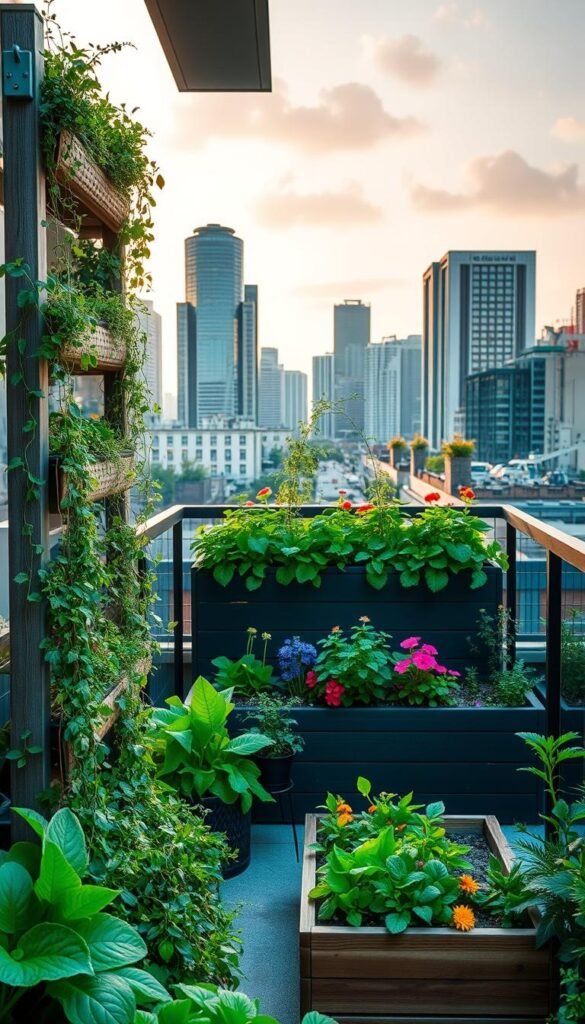
Transforming tight corners into lush retreats starts with a fresh perspective. Forget sprawling lawns—your backyard becomes magical when you layer textures and colors strategically. Think hanging ferns above a foldable bistro set, or herbs growing in repurposed rain gutters along a fence.
Modern design thrives on dual-purpose elements. A bench with built-in planter boxes saves floor space while adding greenery. Stackable containers let you rotate seasonal blooms effortlessly. One landscaper notes:
“Tiny gardens force creativity—every choice must earn its place.”
Urban challenges become opportunities here. Narrow patios shine with vertical succulent walls. Shady spots host vibrant coleus arrangements. For tricky soil, try galvanized troughs filled with quality potting mix—they’re mobile and stylish.
- Mirrors to amplify light and depth
- Dwarf fruit trees in whiskey barrels
- Modular deck tiles over uneven concrete
These approaches prove that constraints fuel ingenuity. Your outdoor zone can entertain, relax, and nourish—all within arm’s reach. What will your first game-changing tweak be?
Assessing Your Outdoor Space Priorities
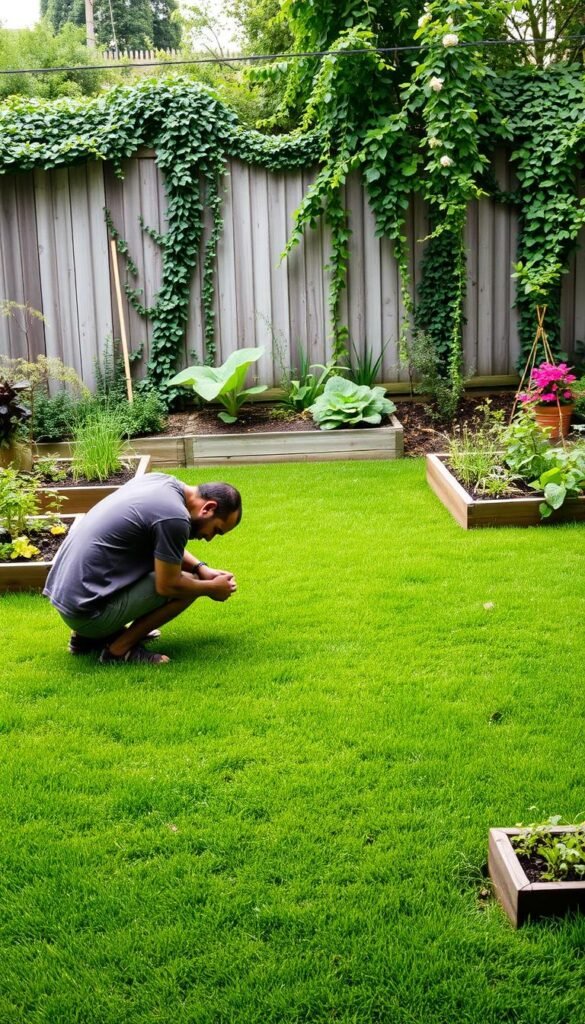
What’s your non-negotiable for that precious patch of green? Before sketching layouts or buying plants, grab a notebook. List every feature you’d love in your backyard—from fire pits to flower garden beds. Then comes the hard part: cutting that list in half.
Identify Your Must-Haves
Start by listing every feature you desire. Dream big! Want a dining area for eight? A play zone for kids? Now rank them by how often you’ll use each. A professional landscaper suggests: “If it’s not used weekly, it’s likely not essential.”
| Family Wish List | Reality Check |
|---|---|
| Outdoor kitchen | Compact grill station |
| Lush lawn | Artificial turf section |
| Separate dining & lounge | Convertible furniture |
Prioritize Function Over Form
That Instagram-perfect water feature? It might steal space from your dog’s running path. Ask yourself: Does this support daily life? Can it serve multiple purposes? Storage benches beat ornamental statues when square footage is tight.
Remember—open space matters too. Leave breathing room between features. Your yard should feel inviting, not cramped. Smart choices today mean fewer regrets tomorrow!
Creating a Functional Layout That Maximizes Every Inch
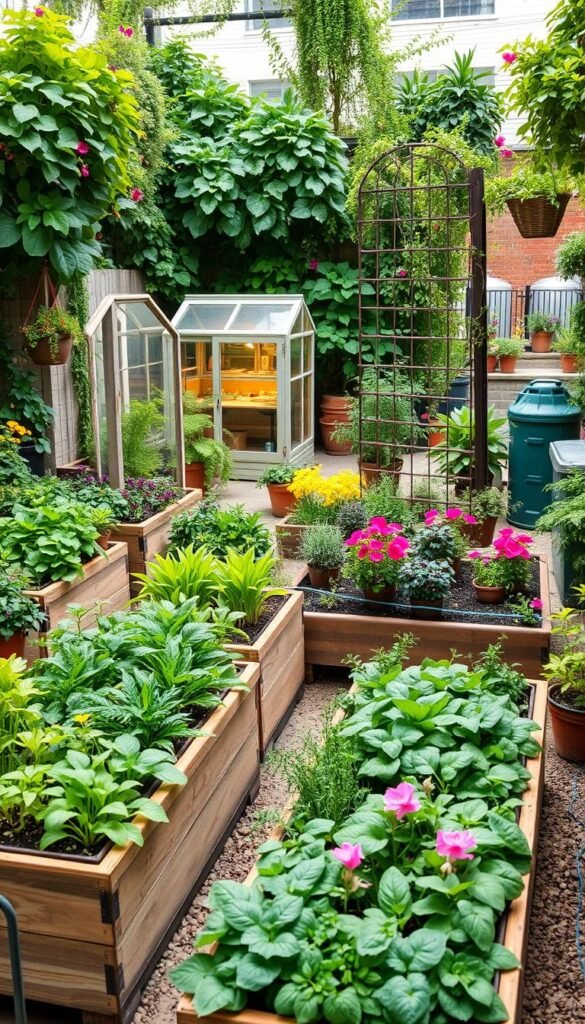
What if your patio could moonlight as an office by day and a dining spot by night? Smart layouts turn limited backyard space into versatile hubs. Start by mapping how you’ll move through your area—like tracing footsteps from seating to storage.
Plan Your Traffic Flow
Think of pathways as your yard’s arteries. Keep them 18-24 inches wide for comfortable movement. Curved walkways save space better than straight lines—they trick the eye into seeing more room. One designer shares: “A winding gravel path uses 30% less square footage than rigid pavers.”
| Common Issue | Space-Saving Fix |
|---|---|
| Narrow walkways | Diagonal stepping stones |
| Dead-end corners | Rotating plant stands |
| Cluttered zones | Fold-down wall tables |
Designing Multi-Use Zones
Your morning coffee nook can transform into an herb-cutting station by afternoon. Try these dual-purpose tricks:
- Bench seating with lift-up storage
- Rolling planter carts that become side tables
- Retractable shade sails over dining spots
As shown in creative small yard layouts, tiered decks create separate zones without walls. Use low hedges or container clusters to mark different areas. For more tips on maximizing your garden’s potential, focus on elements that serve multiple roles—like trellises that provide privacy and support climbing veggies.
Remember: great design makes your garden feel spacious even when working with just a few square feet. Keep sightlines open, and watch your compact oasis blossom!
Maximizing Vertical Space in Small Gardens

Look up—your garden’s next frontier isn’t on the ground. Walls, fences, and overhead areas offer untapped growing potential. Vertical gardens let you stack herbs, flowers, and veggies like living art. This approach isn’t just pretty—it doubles usable space without expanding your footprint.
Vertical Garden Techniques
Living walls turn blank surfaces into lush displays. Try pocket planters filled with strawberries or trailing petunias. Trellises work wonders for climbing plants—beans and morning glories scramble upward naturally. Tiered shelves let you rotate plants seasonally. One urban gardener shares: “My 4-foot-wide balcony grows enough basil for pesto all summer.”
| Technique | Best For | Space Saved |
|---|---|---|
| Wall-mounted pockets | Herbs & succulents | 90% floor area |
| Freestanding trellis | Cucumbers & peas | 3x horizontal space |
| Hanging baskets | Cherry tomatoes | Zero ground use |
Utilize Plant Supports
Metal stakes keep heavy plants like tomatoes upright. Lightweight cages guide delicate vines without crowding. For narrow spaces, use wall-mounted wire grids—they support ivy while adding texture. Always match supports to plant weight. A flimsy trellis collapses under pumpkins, but handles sweet peas perfectly.
Watering tip: Install drip lines along vertical structures. This ensures even moisture without overwatering. Pair sun-loving plants with south-facing walls—they’ll thrive while freeing shaded areas for ferns or hostas. Your garden grows up, not out!
Incorporating Garden Beds, Planters, and Containers
Ever wondered how to grow fresh herbs without digging up your patio? Elevated garden beds and portable containers make it possible. These solutions let you cultivate plants anywhere—balconies, rooftops, or even fire escapes.
Why Raised Beds Work Wonders
Raised garden setups give you control over soil quality and drainage. They’re perfect for areas with poor ground conditions. Build them 12-18 inches tall for easy access—no back strain!
| Material | Lifespan | Best For |
|---|---|---|
| Cedar Wood | 7-10 years | Vegetables |
| Galvanized Steel | 15+ years | Modern designs |
| Recycled Plastic | 5-8 years | Budget projects |
Think Outside the Pot
Container gardens thrive in tight spaces. Use hanging planters for strawberries or stackable pots for herbs. One gardener transformed an old ladder into a vertical display for succulents—genius!
- Repurpose vintage crates for mint and basil
- Use fabric grow bags for root vegetables
- Try self-watering systems for busy schedules
Rotate containers seasonally to keep your garden bed dynamic. In winter, move frost-sensitive plants indoors. Summer? Roll citrus trees into sunny spots. Flexibility is your superpower!
Integrating Creative Hardscape Elements
Your patio’s personality shines through the surfaces underfoot and around you. Smart materials choices create visual flow while solving practical needs. A mix of concrete pavers and smooth river stones, for instance, adds texture without clutter.
Try blending budget-friendly options for maximum impact. Extend existing patios with decomposed granite or use reclaimed bricks as edging. One landscaper notes: “Contrasting textures make compact areas feel curated, not cramped.”
Walkways do more than guide footsteps—they shape how you experience your space. Curved paths using irregular flagstones trick the eye into seeing more room. Keep widths between 24-36 inches for comfortable movement.
| Material | Best Use | Cost Range |
|---|---|---|
| Pea Gravel | Pathways | $2-$4/sq.ft |
| Stamped Concrete | Patio Extensions | $8-$12/sq.ft |
| Porcelain Tiles | Modern Walls | $6-$10/sq.ft |
Don’t overlook vertical walls as design opportunities. Stacked slate becomes living art when paired with creeping thyme. For drainage issues, consider permeable pavers that let rainwater seep through naturally.
Three quick hardscape hacks:
- Use mirror tiles behind seating areas to double light
- Paint concrete slabs with outdoor-safe stains
- Edge raised beds with recycled metal strips
These elements prove that smart surfaces transform how you live in your garden. What ground-level magic will you create first?
Adding Striking Water Features for a Serene Vibe
Imagine the gentle trickle of water transforming your outdoor nook into a peaceful retreat. Even modest water elements create focal points while masking city noise. The key? Choosing features that match your lifestyle and space constraints.
Small Ponds and Fountains
Compact recirculating fountains fit snugly against walls or within planters. Solar-powered models eliminate wiring hassles—perfect for balconies. Pair them with moisture-loving plants like irises for a natural look. For patios, wall-mounted cascades add vertical interest without floor space.
Mini ponds thrive in half-barrels or galvanized troughs. Add floating water lettuce or dwarf lilies for texture. Pro tip: Position features near seating areas to maximize their calming effect. As shown in our guide to elevating your space with thoughtful design, cohesive materials matter. Match copper accents to rustic themes or sleek concrete for modern vibes.
Remember—maintenance matters. Opt for self-cleaning pumps or low-maintenance birdbaths. Your oasis should soothe, not stress. Ready to let liquid serenity redefine your outdoor experience?

